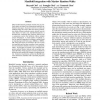Free Online Productivity Tools
i2Speak
i2Symbol
i2OCR
iTex2Img
iWeb2Print
iWeb2Shot
i2Type
iPdf2Split
iPdf2Merge
i2Bopomofo
i2Arabic
i2Style
i2Image
i2PDF
iLatex2Rtf
Sci2ools
AAAI
2008
2008
Manifold Integration with Markov Random Walks
Most manifold learning methods consider only one similarity matrix to induce a low-dimensional manifold embedded in data space. In practice, however, we often use multiple sensors at a time so that each sensory information yields different similarity matrix derived from the same objects. In such a case, manifold integration is a desirable task, combining these similarity matrices into a compromise matrix that faithfully reflects multiple sensory information. A small number of methods exists for manifold integration, including a method based on reproducing kernel Krein space (RKKS) or DISTATIS, where the former is restricted to the case of only two manifolds and the latter considers a linear combination of normalized similarity matrices as a compromise matrix. In this paper we present a new manifold integration method, Markov random walk on multiple manifolds (RAMS), which integrates transition probabilities defined on each manifold to compute a compromise matrix. Numerical experiments...
| Added | 02 Oct 2010 |
| Updated | 02 Oct 2010 |
| Type | Conference |
| Year | 2008 |
| Where | AAAI |
| Authors | Heeyoul Choi, Seungjin Choi, Yoonsuck Choe |
Comments (0)

